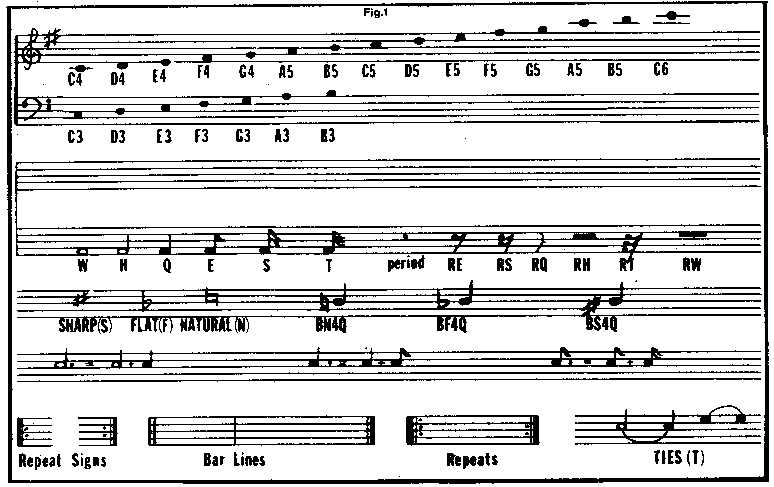for when you are considering using your ATARI to play the notes.
All notes are written on sets of lines and spaces called A Staff. There is one Staff for the Treble or G Clef and another for the Bass or F Clef. Each line and space on the Staff is like the rung on a ladder, one note on a line, and the next note higher in the space above, and so on. The higher the note is on the Staff, the higher it sounds. The Clefs help by giving us the position of one note. If you look at the G Clef you will notice that it draws a ring around the second line, which shows the position for the note G. Using the G note as a reference, it is easy to determine the positions of the other notes on the G Clef, remembering that the other notes run in order up the Staff. G is on the line, A is in the space above, B is on the next line and so on. The Bass or F Clef also gives us the position of a note, the F. This time the F note is always located on the fourth line. You will notice that the big dot on the F Clef symbol marks this position.
Notes have many different shapes. Each shape lasts for a certain number of beats which can be counted. A WHOLE NOTE lasts for four beats, which you would count 1-2-3-4, in time with the music. A HALF NOTE lasts for two beats (half as long as a Whole Note) and so on. To make counting easier, music is divided with vertical lines called BAR LINES. Bar Lines do not stop the beat. You should count as if they don't exist and are used to help separate the beats when counting. A DOUBLE BAR LINE marks the end of a piece of music, and can also divide music into sections or Phrases.
Most music has more notes than can be shown on the five lines and four spaces of the Staff, These notes are written in the areas above and below each Staff on short lines. These notes are worked out in exactly the same manner as the notes we have already discussed. After a while you will come to recognize these notes.
In most music, one or more of the instruments or voices are silent for a few beats. These silent beats are known as RESTS. Rests are counted in the same way as the notes they replace, i.e. a whole rest lasts as long as a whole note and has the same number of beats. Rests can be found at the beginning or end of music, or between the different Phrases of a melody.
When a note is carried on into the next bar, a curved line called a TIE is used. A Tie makes the first note longer by joining it to the note at the beginning of the next bar. Ties can also join two or more notes together in the same bar, and will make the first note last for the combined number of beats of the notes tied together. Ties will only work with notes that have the same name and position on the Staff with no different notes in between. Do not confuse a SLUR for a Tie. A Slur can be used over or under several different notes and means that those notes should be played smoothly.
I could devote this entire issue to the basics of music. However, the information we have covered so far should help most of you in getting started. If you need additional information, refer to the chart or the Music Composer manual. In future issues we will get into music a little deeper and explain what your ATARI is capable of. I will also have a few song listings that you can use. Any requests?
